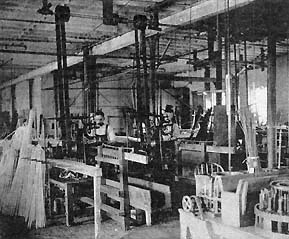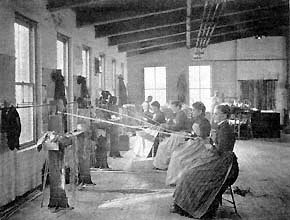 The Rolling Machine.
The Rolling Machine.
|
In 1855, a self-plaiting machine turned by a crank, came into use by American design and ingenuity. This improvement tended to increase the Whip industry about a third in five years, and during the next
semi-decade this invention was largely improved upon, and in 1865 Westfield produced about one-half a million dollars’ worth of whips. Trade in whips largely increased, companies were formed, and a year later statistics showed that
WESTFIELD LED THE WORLD
in the extent of her whip industry.
So great has been the advance in the value of the product that what stood for the sum of it in 1865, does not now serve to represent the sales of more than one factory!
Hiram Hull, spoken of in the quotation above, is practically the inventor of scientific whip making, as he was the founder of the American Whip Company, which under his guidance pioneered the industry and later, through the energy and tact of Ira Miller, its present chief officer, has assumed a leading position, with the enormous output of over two million five hundred thousand whips per annum!
 The Whalebone Rack.
The Whalebone Rack.
|
As the experiments, trials and successes of Mr. Hull were actually a part of the history of the American Whip Company, under the various firm and corporate names, it is fitting that we take this great factory as typical of the growth of whip making, and in detailing its progress and methods of
manufacture we shall really be
GOING TO THE FOUNTAIN HEAD FOR FACTS.
The process I shall describe will be confined to the "bow" or straight whip, because it is typical, although the American Whip Company makes a great variety of all merchantable styles of whips.
The bow whip is simplicity itself. It is composed of what is technically known as the "stock" and a "snap," but the processes that are gone through to produce this simplicity are really quite intricate.
Entering the office of the American Whip Company, I first note that the clerical force in the office department does not seem to be numerous. Here is the first evidence of a carefully evolved system that grows on one as he proceeds. No superfluous persons hold down
office stools; no unnecessary employe’s stand around to block progress. For convenience I will suppose I am
AN ORDER FOR ONE HUNDRED DOZEN
of whips, and will go through the factory, much as such an order would go, skipping now and then some details, for the sake of brevity and continuity of narrative.

Braiding Leather Lashes.
|
The order tag never skips, as you may judge when I tell you that this tag is handled some one hundred and fifty times before it is filled on the completion of the order.
When the tag is duly filled in with the particulars of the order, the first step is in the direction of the rattan house. This is a storage building situated to one side of the main factory, in which is stored thousands of dollars’ worth Singapore rattan. It is unassorted just as it has arrived from the vessel that landed it in New York.
It is one man’s duty to select it, grade it and pass it on into the works. This seems simple, but it is a work of nice discrimination, perfection in it only being acquired by long practice in handling the bundles.

Whip.
|
Meantime, in a large room, that is the basement of the front building of the works, are men employed selecting the whalebone, which is here stored in bundles in racks that look like nothing so much as the pigeonhole contrivance they have in hotel coat rooms for stowing away one’s baggage. The contents of these racks, however, mount to thousands of dollars in value.
AA POUND OF WHALEBONE
does not amount to much in hulk; neither does a ten-dollar bill, which is its equivalent.
The bone, as it is called, is not as straight as the narrow path, at first, but it must be made so before it can become fitted to its use. This is where you come into contact with the first expert. Men take the slender wands, and by careful manipulation,
using heat, sandpaper and patience, finally square, round, taper and point the bone, until its condition is perfect for whip purposes.
Some of the whips in my order call for hide "centers." The raw hide is twisted into long, thin sticks that in form resemble the bone. When dry it is sandpapered and polished and pointed with the same care and accuracy as the bone.
The center, I should perhaps explain, is that part of the stock that extends upward, making the tip end. It gives the flexibility and snap that a good whip possesses. The depth of these centers varies. A "full hone" whip has a whale bone center extending nearly or quite to the butt end, or handle. A quarter bone, of course, does not go down so deep;
THE PRICE GOVERNS THAT.
While they are Working away at these "centers," the rattan in another section of the works, has
gotten into trouble. The man who selected it and passed it on from the storehouse, merely took off the rough edge, so to speak, in his work, careful as it was. Passing into other expert hands, it is reassorted as to size, length and quality, and then for the first time gets really down to business. It is put through machines that split it accurately into triangular pieces that are called "wedges," and into other pieces named "sidings." A stick of rattan is not of large diameter, as you know, hut these machines cut it as perfectly as if it were as large as a saw log.
At this initial stage of the proceedings the "stock" begins to evolve. It is a sort of natural selection process. These wedges and sidings are assembled in a particular manner so as to form a long stick with a merely nominal taper at one end. They form this stick in a manner that gives it
strength. An iron spike is inserted in the hickory "butt," a part that becomes the handle of the whip. This spike stays just where it is placed, during the whole performance, and is the weight producer, without which theirs would be no balance or proper "feel" to the whip. There is
© Laurel O’Donnell 1996 - 2006, all rights reserved
This document may be downloaded for personal non-commercial use only
and may not be reproduced or distributed without permission in any format.
This is an edited adaptation from the original publication.
|